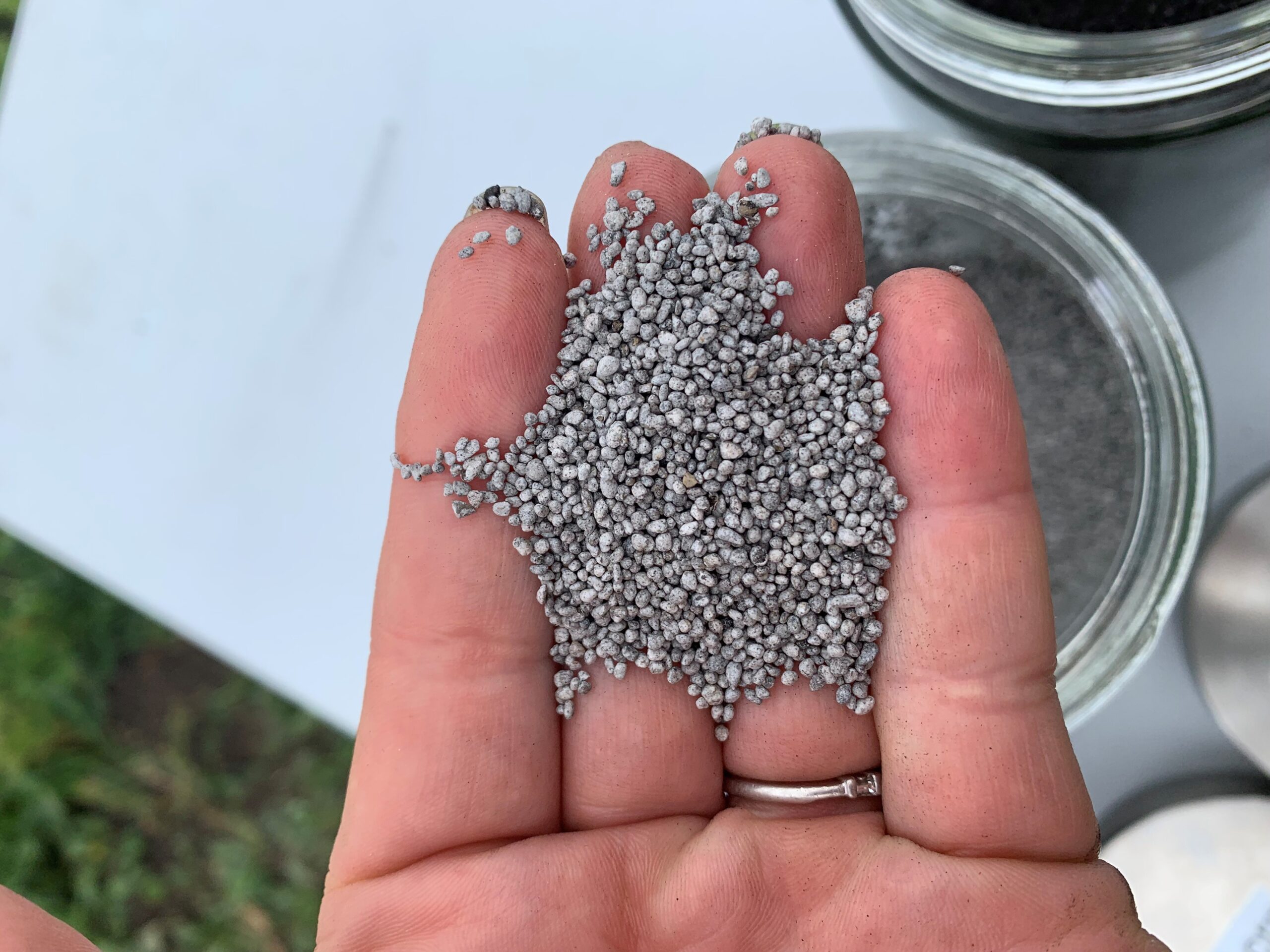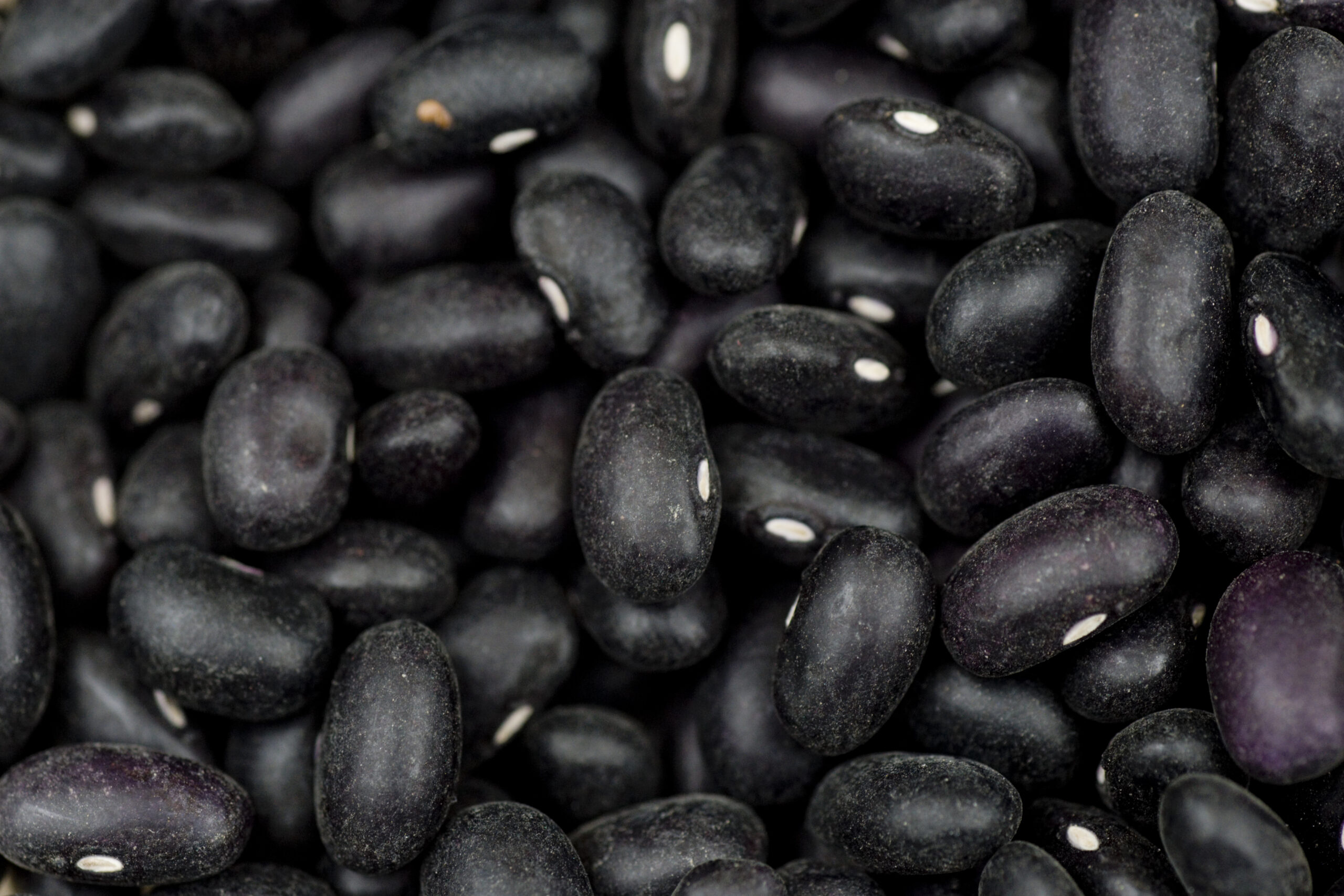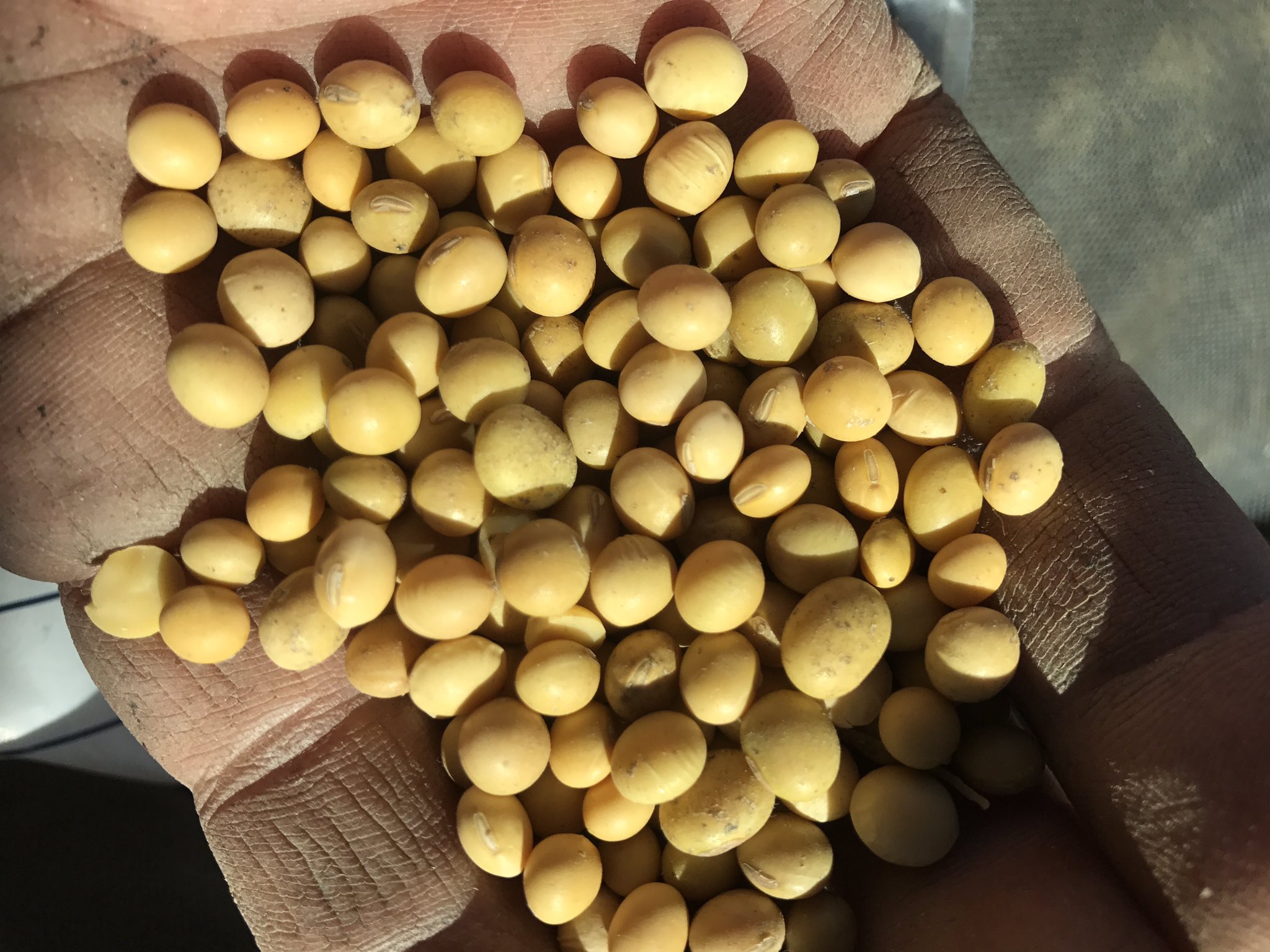Pulse crops grown in Western Canada are able to fix much of their nitrogen requirements from gaseous nitrogen found in the soil atmosphere surrounding the root hairs. This is done through a beneficial relationship between a pulse crop and soil Rhizobium bacteria.
Why Inoculate?
Research by Dr. Fran Walley at the University of Saskatchewan (U of S) found that pulse crops inoculated with the proper Rhizobium have the potential to fix 50-80% of nitrogen requirement through nitrogen- fixation, although the amount differs by crop. For example, faba beans were found to fix around 90% of their requirements, while dry beans were less than 40%. Generally, pulse crops are ranked according to their estimated ability to fix nitrogen: faba beans > peas > chickling vetch > chickpeas > lentils > soybeans > lupin > dry beans.
Rhizobia live freely in the soil and can persist for several years even in the absence of a pulse crop. However, even though the rhizobial community may be present in the soil, these native strains may not be the most effective nitrogen-fixers, and introduced strains can lose their ability to fix nitrogen effectively. Additionally, the rhizobia bacteria that form a relationship with chickpeas and soybeans are
not native to Western Canadian soils. As a result, inoculation of pulse seed with rhizobia bacteria will result in optimum nitrogen-fixation and yield. Inoculation ensures the most effective strain is in high enough numbers near the root zone to maximize nodulation.
Rhizobium Inoculant Species
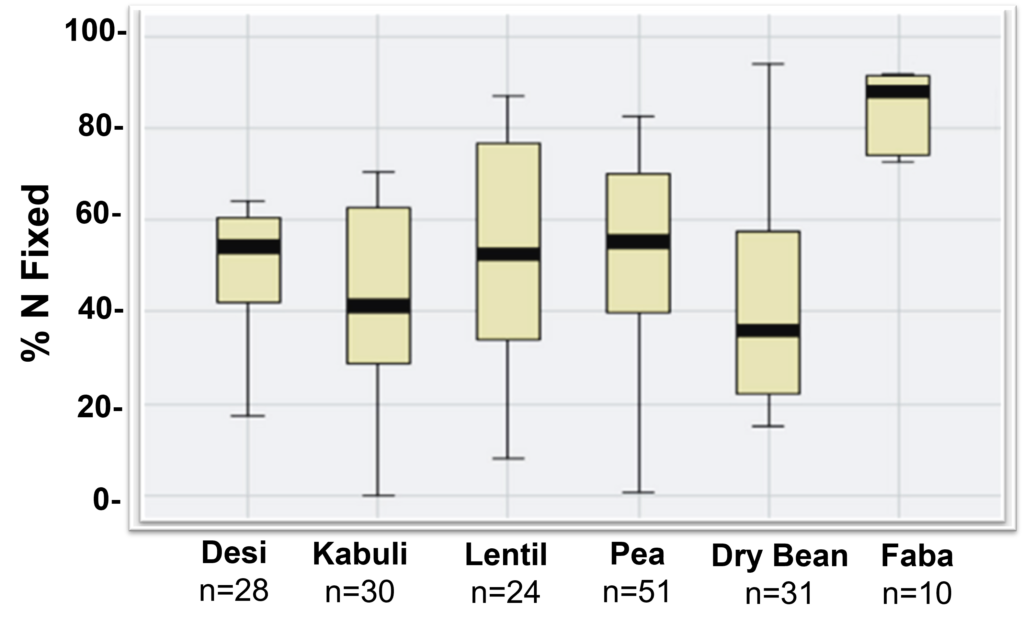
The data was compiled from published research reports and papers.
The thick dark line indicates the median value, the box represents 50% of all data, and the whiskers contain the remaining 50% of the data.
Source: Dr. Fran Walley, University of Saskatchewan
An inoculant carries a specific Rhizobium species that matches up with a specific pulse crop. Choose the correct species for each crop.
Table 1. Rhizobium Species Required for Pulse Crops
| Peas, Lentils, Faba Beans | Rhizobium leguminosarum |
| Chickpeas | Rhizobium ciceri |
| Dry Beans | Rhizobium phaseoli |
| Soybeans | Bradyrhizobium japonicum Bradyrhizobium elkanii |
Inoculating Pulse Crops with Rhizobium
Inoculation is the process of introducing nitrogen fixing bacteria onto the seed or into the soil in close proximity to the seed to ensure successful nodulation. The bacteria must come in contact with the developing seedling for infection of root hairs to occur in order to initiate the nitrogen-fixation process. Table 2 lists products available.
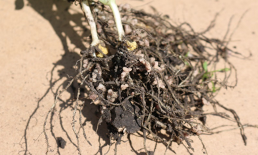
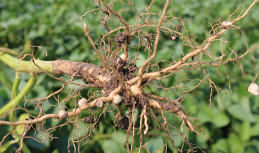
Rhizobium Inoculant Formulations
Inoculants come in several different formulations. The choice of inoculant formulation depends on application convenience, and in some cases, performance.
Peat-Based Powder – Rhizobium bacteria are contained within a peat- based powder carrier. They can be applied as a dry powder directly on the seed or in a slurry with water which assists with seed adherence. Peat-based formulations are messier formulations to handle and apply to the seed than liquid formulations. Some peat products require addition of a sticker if not already contained within the formulation (i.e., self-sticking formulations). Commercial sticker products are available if needed. An advantage of peats over liquids is the ability of peat to hold moisture which can prevent desiccation of the rhizobia on seed, particularly when conditions at seeding are dry. Peat-based formulations may also be made from sterile or non-sterile peat and differ in their acceptance by organic certifying bodies.
Liquid Based – Rhizobium bacteria are contained within a liquid, and the formulation is applied directly onto the seed to give a desired population of rhizobia per seed. Some liquid inoculants are also registered for application directly to the soil in the seed row as in- furrow applications. Liquid inoculants are easy to use and much less messy compared to peats. Stabilizers and extenders help protect rhizobia in the liquid formulations.
Granular Based – Rhizobium bacteria are formulated in a granule that is applied directly into the furrow close to the seed. Granular formulations differ in the carriers used and range from peat-, to clay-, to synthetic-based granules. The product application rates are based on applying a specific weight per area or per row which requires a higher volume of material to be handled compared to peats or liquids. Applying it through seeding equipment allows for accurate applications and less mess compared to seed applied inoculants. Granular inoculants provide protection from the elements for the rhizobia. Some manufacturers also allow side-banding a granular inoculant. A separate tank and meter is required. Do not mix and apply with fertilizer.
Pre-Inoculated Seed – Seed is treated with a peat-based or liquid inoculant encapsulated with a seed coating at a commercial facility prior to purchasing the seed. No further inoculation is required and this formulation provides a longer shelf life (often weeks) for the viability of the inoculant on seed compared to direct seed inoculation on-farm (hours or days).
Double Inoculation with Rhizobium
Research in Manitoba and Saskatchewan has shown a yield benefit of double inoculation on first and second time soybean fields. Typically a liquid or peat inoculant would be seed-applied along with a granular or liquid in-furrow application.
A three-year study at the Indian Head Agricultural Research Foundation (IHARF) with sites at Indian Head and Melfort, found highly significant yield response to a liquid inoculant on the seed and a granular inoculant applied in-furrow at the recommended label rate. At these sites with no previous soybean history, there were strong yield responses to dual inoculation with a mean overall yield increase of 7.4 bushels per acre (497 kilograms per hectare) or 24%. At the Outlook site that had a history of soybean production in two previous rotation cycles, there was no practical benefit of dual inoculation.
On fields where soybeans have been grown previously, Manitoba Pulse and Soybean Growers provides a checklist for growers to decide if dual inoculation is necessary. The IHARF research suggests that Saskatchewan soybean growers could also follow this checklist when deciding whether to continue double inoculation. When all of the following conditions are met, single inoculation is likely to be sufficient:
- The field has had at least two previous soybean crops
- Previous soybean crops have nodulated well
- The most recent soybean crop was within the past four years
- No significant flooding or drought
No benefit of double inoculation has been seen in lentils, peas, faba beans, and chickpeas. However, if soils have been flooded or have not seen a pulse in many years, the native rhizobial population may be low, so double inoculation can ensure good establishment of nodules, although at a significant additional cost.
Inoculant Performance
All inoculants deliver rhizobia bacteria to the soil, so all inoculants can be successful if the bacteria multiply, colonize the roots, and ultimately cause nodulation to occur. However, there are circumstances where some formulations do a better job in keeping the rhizobia alive. Generally granular products are more forgiving of stressful conditions (dry, hot, etc.) but even granular formulations can fail if the conditions simply do not allow the bacteria to survive.
Research at Agriculture and Agri-Food Canada (AAFC) Indian Head and AAFC Melfort evaluated inoculant formulations in peas. When soil moisture conditions were below normal, the granular formulation performed better than the seed-applied peat-based powder, which performed better than seed-applied liquid formulation. However, when soil moisture was normal and soil organic matter levels exceeded 6%, no difference was found among formulations.
Similar results were found in U of S research on chickpeas. Peat-based and liquid inoculants were applied directly to the seed, and granular inoculants were applied either in the seed row or placed in a sideband, 2.5 centimetres (cm) or one inch (in) to the side, and at depths of either 2.5 or 8 cm (1 or 3 in.) below the seed. The peat-based powder and liquid formulations performed as well as the granular formulation, usually when soil moisture was not limited. Under drier soil conditions, granular products usually outperformed the seed-applied formulations.
In research conducted at AAFC Brandon and AAFC Indian Head, liquid inoculant formulations were tested for their performance as a soil treatment when dribbled into the seed row or as a sideband.
Treatments included a liquid formulation suspended in a water solution and applied to the soil, a granular formulation applied to the soil, a liquid formulation applied to the seed, and an untreated check. The soil-applied liquid and granular formulations performed equally, and all formulations and application methods increased seed yield over the non-inoculated check.
Placement of Rhizobium Inoculant
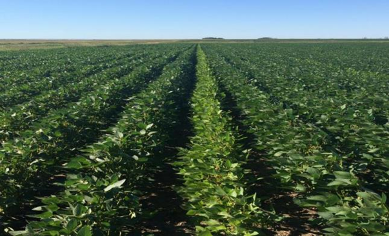
Rhizobium bacteria infect root hairs where the inoculant is placed. The roots need to come in contact with the rhizobia, so placing the inoculant too far from the emerging roots can slow the development of nodules and the start of nitrogen-fixation. As a result, seed row placement of granular inoculants is generally recommended.
Sideband placement, approximately one inch below and one inch to the side of the seed, may be effective. However, not all manufacturers recommend sideband placement, and high fertilizer rates in the same band may cause injury to the bacteria. Contact the manufacturer for recommendations specific to sidebanding inoculants.
Placement in a mid-row banding is not a good option as late infection and nodulation could result in late nitrogen-fixation, especially under dry conditions.
Rhizobia tend to form nodules close to where the bacteria are placed, so seed-placed inoculants lead to a greater portion of nodules forming close to the crown area on the main tap root and lateral roots close to the inoculant placement. Soil-applied granular inoculants tend to form nodules on lateral roots, closer to where the granules were delivered in or near the seed row.
Other Microorganisms & Additives
In addition to Rhizobium bacteria, some inoculants contain additional organisms and compounds that may aid in the nitrogen-fixing process or have other benefits for the crop (Table 2).
Plant growth promoting rhizobacteria (PGPRs) grow in the root zone (rhizosphere) and can stimulate plant growth through various mechanisms including increased availability, mobility, and uptake of nutrients by the plant. PGPRs include bacterial species Pseudomonas, Azotobacter, Enterobacter, Alcaligenes, Arthrobacter, Azospirilium, Klebsiella, Burkholderia, Bacillus, and Serratia. Some Rhizobium inoculant products are also packaged with PGPRs.
Fixing nitrogen is a process requiring a lot of energy from the plant. This energy comes from photosynthesis and is transferred in the root zone through a coenzyme called adenosine triphosphate (ATP).
Phosphorus is one of the main components of this coenzyme and therefore proper phosphorus uptake is crucial to provide the energy needed to fix nitrogen. Some microorganisms are known to have a positive impact on phosphorus uptake. Penicillium bilaiae, for example, is a fungus that produces organic acid that break the link between phosphorus and calcium in high pH soils. Other bacteria like Bacillus velezensis are also able to produce these organic acids but also synthesize enzymes that can mineralize organic phosphorus for easy uptake by the plant that would normally not be available.
Arbuscular mycorrhizal fungi (MF) are another group of organisms that form symbiotic relationships with plants such as pulses. They grow on plant roots and spread into the root tissue to provide a network that helps the roots access more nutrients and water through acting as extensions of the root systems. Healthier plants have improve stress resistance and ability to tolerate presence of some pathogens. MF are present in the soil but there are also products that can be seed applied to increase their presence such as those containing the fungus Rhizophagus irregularis (previously known as Glomus intraradices).
Biological fungicides are a newer class of organisms and include specific species and strains with activity on controlling pests and pathogens. With inoculants there is increasing interest in combining them with bio fungicides to help keep roots healthy. Organisms that have been registered with bio fungicidal properties include Bacillus amyloliquefaciens strain MBI 699 (Integral®) for partial suppression of seedling diseases caused by Fusarium spp. and Rhizoctonia spp.
Lipo-chitin oligosaccharides (LCOs) are another type of additive found in select products. The nodulation process starts with the pulse root secreting flavonoids, which are sensed by the rhizobia. In response, the rhizobia produce their own signal (Nod factor) back to the plant, and the plant responds by allowing the root hair to be infected by the rhizobia. These Nod factors are often called LCOs, and can be included in some inoculants.
Gluconacetobacter diazotrophicus (Gd) iss a bacteria isolated from sugarcane. The patented strain (Envita®) enables most crops, including pulses, cereals, and canola, to fix nitrogen. Like rhizobia, Gd utilizes the nitrogenase enzyme to fix nitrogen. However, instead of fixing nitrogen in root nodules outside of the plant, Gd systemically enters the roots, stems, and leaves of the crop and fixes nitrogen inside plant cells. A rhizobia inoculant should be used in combination with Envita®. Gd starts fixing nitrogen quickly and can fix nitrogen before rhizobium root nodules are formed. Envita does not impact nodule formation or reduce rhizobia efficacy and can be applied in-furrow or as a foliar application.
Biological products and additives can be confusing in terms of the registration process and label claims. Inoculants sold in Canada are registered under The Fertilizers Act administered by the Canadian Food Inspection Agency. Many of the additives are also registered through this same process. For additives or biologicals with fungicidal activity or pest control label claims they are registered through The Pest Control Act administered by the Pest Management Regulatory Agency.
Limited independent research has been conducted on some of these organisms or compounds, and pulse growers are advised to leave check strips when using products with these additional additives to assess their value.
Seed Treatment Compatibility
Seed treatments (fungicides and insecticides) vary with their impact on the viability of inoculants. Always read and follow product labels, and contact your inoculant manufacturer for guidelines on the proper use of combinations of seed treatments and seed applied inoculants. Sequential application where the seed treatment is applied to the seed and allowed to dry before the inoculant is applied to the seed is usually the safest method.
Seed Treatment Compatibility
| Company | Label (click for compatability link) |
|---|---|
| BASF | Nodulator® LQ (liquid) – soybean |
| Nodulator® XL (liquid & peat) – pea, lentil | |
| BrettYoung | BrettYoung inoculant products |
| Lallemand | LALFIX – pea, lentil |
| Nexus BioAg | Nexus BioAg inoculant products |
| NutriAg | BOS™ |
| PremierTech | AGTIV® inoculant products |
| XiteBioTechnologies Inc. | PulseRhizo® |
| SoyRhizo® | |
| Yield+ | |
| OptiPlus® | |
| Verdesian | N-Charge, LIFT-Kit, Primo, N-Take |
Storage and Handling
For all formulations, inoculants contain living bacteria and must be stored in a condition to maintain viability. Keep cool and out of direct sunlight. Follow manufacturer recommendations for storage. Check the product expiry date, which displays when the number of live bacteria is no longer guaranteed.
Once seed is treated with a liquid or peat inoculant, the inoculated seed should be seeded as quickly as possible. Try to treat only the amount of seed that can be planted in one day without leaving the product overnight in the nurse truck or air seeder compartment.
Although nitrogen-fixing inoculants are generally non-toxic, the use of protective equipment, including gloves, goggles, and an approved respirator is recommended. When mixed with seed treatment fungicide and insecticides, follow handling and safety recommendations for those products.
Table 2. Inoculant Options for Pulse Crops
| Inoculant Products | Company | Description | Non Nitrogen-Fixing Technology1 | Liquid | Peat | Granular | Organic Acceptance4 |
|---|---|---|---|---|---|---|---|
| Lentil/Pea | |||||||
| AGTIV® THRIVE™ Pea & Lentil | Premier Tech (Taurus) | R. leguminosarum biovar viceae + Rhizophagus irregularis | MF | X | X | Yes | |
| AGTIV® FUEL™ Pea & Lentil | Premier Tech (Taurus) | R. leguminosarum biovar viceae | X | X | X | Yes | |
| BOS™ Pea, Lentil & Faba Beans | NutriAg | R. leguminosarum biovar viceae + Pseudomonas sp. | PGPR + P + BGP | X | X | X | Yes – Peat & Granular only |
| Cell-Tech® Pea/Lentil | Nexus BioAg | R. leguminosarum | X | X2 | X | Yes | |
| LALRISE® START SPHERICAL PULSES | Lallemand Plant Care | R. leguminosarum biovar viceae (dual strains) + Bacillus velezensis | PGPR + P | X | |||
| LALFIX® SPHERICAL Pea & Lentil | Lallemand Plant Care | R. leguminosarum biovar viceae (dual strains) | X | ||||
| LALFIX® PEAT Pea & Lentil | Lallemand Plant Care | R. leguminosarum biovar viceae (dual strains) | X | Yes | |||
| LALFIX® LIQUID Pea & Lentil | Lallemand Plant Care | R. leguminosarum biovar viceae (dual strains) | BioProtector Add-It | X | |||
| Launcher™ Pea/Lentil | BrettYoung | R. Leguminosarum biovar viceae | X | Yes | |||
| N-Charge® Pea, Lentil, Faba Bean | Verdesian | R. leguminosarum biovar viceae | X2 | ||||
| N-Dure® Pea, Lentil, Faba Bean | Verdesian | R. leguminosarum biovar viceae | X2 | Yes | |||
| N-Row® Pea, Lentil, Faba Bean | Verdesian | R. leguminosarum biovar viceae | X | ||||
| N-Take™ Pea, Lentil, Faba Bean | Verdesian | R. leguminosarum biovar viceae | X | ||||
| Nodulator® Duo SCG | BASF | R. leguminosarum biovar viceae + Bacillus subtilis | PGPR | X | |||
| Nodulator® XL LQ | BASF | R. leguminosarum biovar viceae | X | Yes | |||
| Nodulator® XL Peat | BASF | R. leguminosarum biovar viceae | X | Yes | |||
| Osmium™ Pea/Lentil | BrettYoung | R. leguminosarum biovar viceae | Osmo Protector | X | Yes | ||
| Primo GX2 | Verdesian | Rhizobium + Azospirilium | PGPR | X | |||
| LIFT Kit Pulse | Verdesian | Rhizobium + Azospirilium + Take Off® | PGPR + N catalyst | X | |||
| TagTeam® LCO | Nexus BioAg | R. leguminosarum + P. bilaiae + lipochitooligosaccharide | P + LCO | X | |||
| TagTeam® Pea & Lentil | Nexus BioAg | R. leguminosarum + P. bilaiae | P | X | X | ||
| TagTeam® BioniQ® | Nexus BioAg | R. leguminosarum + P. bilaiae + Bacillus amyloliquefaciens + Trichoderma virens + lipochitooligosaccharide | P + LCO + PGPR | X | |||
| XiteBio® PulseRhizo® | XiteBio Technologies Inc. | R. leguminosarum + AGPT® | AGPT® | X | Yes | ||
| Faba Bean | |||||||
| AGTIV® THRIVE™ Pea & Lentil | Premier Tech (Taurus) | R. leguminosarum + Rhizophagus irregularis | MF | X | X | Yes | |
| AGTIV® FUEL™ Pea & Lentil | Premier Tech (Taurus) | R. leguminosarum biovar viceae | X | X | X | Yes | |
| BOS™ Pea, Lentil & Faba Beans | NutriAg | R. leguminosarum biovar viceae + Pseudomonas sp. | PGPR + P + BGP | X | X | X | Yes – Peat & Granular only |
| LALRISE® START SPHERICAL PULSES | Lallemand Plant Care | R. leguminosarum biovar viceae (dual strains) + Bacillus velezensis | PGPR + P | X | |||
| LALFIX® SPHERICAL Pea & Lentil | Lallemand Plant Care | R. leguminosarum biovar viceae (dual strains) | X | ||||
| LALFIX® PEAT Pea & Lentil | Lallemand Plant Care | R. leguminosarum biovar viceae (dual strains) | X | Yes | |||
| LALFIX® LIQUID Pea & Lentil | Lallemand Plant Care | R. leguminosarum biovar viceae (dual strains) | BioProtector Add-It | X | |||
| N-Charge® Pea, Lentil, Faba Bean | Verdesian | R. leguminosarum biovar viceae | X2 | ||||
| N-Take™ Pea, Lentil, Faba Bean | Verdesian | R. leguminosarum biovar viceae | X | ||||
| N-Dure® Pea, Lentil, Faba Bean | Verdesian | R. leguminosarum biovar viceae | X2 | Yes | |||
| N-Row® Pea, Lentil, Faba Bean | Verdesian | R. leguminosarum biovar viceae | X | ||||
| Osmium™ Pea/Lentil | BrettYoung | R. leguminosarum biovar viceae | Osmo Protector | X | Yes | ||
| Primo GX2 | Verdesian | Rhizobium + Azospirilium | PGPR | X | |||
| LIFT Kit Pulse | Verdesian | Rhizobium, Azospirilium, Take Off® | PGPR + N catalyst | X | |||
| TagTeam® Faba Bean | Nexus BioAg | R. leguminosarum + P. bilaiae | P | X | |||
| XiteBio® PulseRhizo® | XiteBio Technologies Inc. | R. leguminosarum + AGPT® | AGPT® | X | Yes | ||
| Chickpea | |||||||
| THRIVE™ Chickpea | Premier Tech (Taurus) | Mesorhizobium ciceri + Rhizophagus irregularis | MF | X | X | Yes | |
| LALRISE® START SPHERICAL PULSES | Lallemand Plant Care | R. leguminosarum biovar viceae (dual strains) + Bacillus velezensis | PGPR + P | X | |||
| LALFIX® PEAT Chickpea | Lallemand Plant Care | Mesorhizobium ciceri | X | ||||
| N-Charge® Garbanzo/Chickpea | Verdesian | Mesorhizobium ciceri | X2 | ||||
| N-Dure® Garbanzo/Chickpea | Verdesian | Mesorhizobium ciceri (OMRI Cert) | X2 | Yes | |||
| Nodulator® CP SCG | BASF | Mesorhizobium ciceri | X | ||||
| Osmium™ Chickpea | BrettYoung | Mesorhizobium ciceri | Osmo Protector | X | Yes | ||
| Primo | Verdesian | Mesorhizobium ciceri | Extender | X | |||
| Primo GX2 | Verdesian | Mesorhizobium ciceri + Azospirilium | PGPR | X | |||
| TagTeam® Chickpea | Nexus BioAg | Mesorhizobium ciceri + P. bilaiae | P | X | X | ||
| Dry Bean | |||||||
| BOS™ Dry Bean | NutriAg | R. leguminosarum bv. Phaseoli + Pseudomonas | PGPR + P + BGP | X | Yes | ||
| N-Charge® Dry Bean | Verdesian | R. leguminosarum bv. phaseoli | X | ||||
| N-Dure™ Dry Bean | Verdesian | R. leguminosarum bv. phaseoli | X2 | ||||
| Soybean | |||||||
| AGTIV® ENRICH™ Soybean | Premier Tech (Taurus) | B. japonicum + Bacillus subtilis | PGPR | X | Yes | ||
| AGTIV® FUEL™ Soybean | Premier Tech (Taurus) | B. japonicum | X | X | |||
| AGTIV® THRIVE™ Soybean | Premier Tech (Taurus) | B. japonicum + Rhizophagus irregularis | MF | X | X | ||
| BOS™ Soybean Inoculant | NutriAg | B. japonicum + Pseudomonas sp. | PGPR + P + BGP | X | X | Yes | |
| Cell-Tech® Soybean | Nexus BioAg | B. japonicum | X | X | X | ||
| LALFIX® START SPHERICAL Soybean | Lallemand Plant Care | B. elkanii (dual strains) + Bacillus velezensis | PGPR + P | X | |||
| LALFIX® SPHERICAL Soybean | Lallemand Plant Care | B. japonicum (dual strains) | X | ||||
| LALFIX® PROYIELD Liquid Soybean | Lallemand Plant Care | B. elkanii (dual strains) + Delftia actinozoans | PGPR + Fe solubilizing, BioProtector Add-It | X | |||
| LALFIX® LIQUID Soybean | Lallemand Plant Care | B. elkanii | BioProtector Add-It | X | |||
| LALFIX® PEAT Soybean | Lallemand Plant Care | B. elkanii (dual strains) | X | ||||
| Launcher™ Soybean | BrettYoung | B. japonicum | X | X | Yes | ||
| N-Charge® Soybean | Verdesian | B. japonicum | X2 | ||||
| N-Dure® Soybean | Verdesian | B. japonicum | X2 | Yes | |||
| N-Row® Soybean | Verdesian | B. japonicum | X | ||||
| N-Take™ Soybean | Verdesian | B. japonicum | X | ||||
| Nodulator® LQ | BASF | B. japonicum | X | Yes | |||
| Nodulator® IP Plus | BASF | B. japonicum + Bacillus amyloliquefaciens + Bacillus subtilus | PGPR | X3 | |||
| Nodulator® SCG | BASF | B. japonicum | X | ||||
| Optimize® LV | Nexus BioAg | B. japonicum + lipochitooligosaccharide | LCO | X | |||
| Primo R1 | Verdesian | B. japonicum | X | ||||
| Primo GX2 Soybean | Verdesian | B. japonicum (multiple strains) + Azospirilium brasilense | PGPR | X | |||
| Preside® Ultra | Verdesian | B. japonicum (multiple strains) + Azospirilium brasilense | PGPR | X | |||
| Signum® Soybean | BrettYoung | B. japonicum | Osmo Protector & Bio-Inducer | X | Yes | ||
| TagTeam® Soybean | Nexus BioAg | B. japonicum + P. bilaiae | P | X | X | ||
| XiteBio® OptiPlus® | XiteBio Technologies Inc. | B. japonicum + AGPT® + Bacillus firmus | AGPT® + P + PGPR | X | Yes | ||
| XiteBio® SoyRhizo® | XiteBio Technologies Inc. | B. japonicum + AGPT® | AGPT® | X | Yes | ||
1PGPR (plant growth promoting rhizobacteria); AGPT® (advanced growth promoting technology); LCO (lipochitooligosaccharide); P (phosphate solubilizing or enhancing); MF (mycorrhizal fungi); BGP (biological growth promotor)
2Non-sterile peat option or only non-sterile peat
3For professional treaters only, provides 100 days on-seed viability
4Product(s) are available in formulations that are acceptable by organic standards. Check with company for more information and certifications.
Table 3. Seed/Soil Applied Technology (Non Rhizobium Component)
| Product | Company | Inoculant Microorganism & Additives | Technology1 | Peas | Lentils | Faba Beans | Chickpeas | Soybeans | Dry Beans | Organic Acceptance |
|---|---|---|---|---|---|---|---|---|---|---|
| Accolade® L | Verdesian | Azospirilium brasilense | PGPR | X | X | X | X | X | X | |
| AGTIV® REACH™ | Premier Tech (Taurus) | Rhizophagus irregularis | MF | X | X | X | X | X | X | |
| BioProtector Add-it | Lallemand Plant Care | Extender adjuvant for LALFIX® PROYIELD | Extender adjuvant | X | ||||||
| Consensus™ L | Loveland (Nutrien) | Chitosan & Salicylic acid & Indole-3-butryic acid | PGPR | X | X | X | ||||
| Envita® | Azotic North America (Syngenta) | Gluconacetobacter diazotrophicus | N | X | X | X | X | X | X | |
| JumpStart® | Nexus BioAg | Penicillium bilaiae | P | X | X | X | X | X | X | Yes |
| LALRISE® START SC | Lallemand Plant Care | Bacillus velezensis | PGPR + P | X | X | X | X | X | X | Yes |
| M-BOS™/M-BOS ST | NutriAg | Methylobacterium organophilum | PGPR/Improves tolerance to abiotic stress. Increases production of essential compounds like Cytokinins, Amino Acids, Sugars, Nucleic Acids, Vitamins, and Coenzymes. | X | X | X | X | X | X | |
| QuickRoots® | Nexus BioAg | Bacillus amyloliquefaciens & Trichoderma virens | PGPR/improves nutrient & moisture uptake | X | X | X | ||||
| Recover® PO4 | BrettYoung | P. bilaiae | P | X | X | X | X | X | ||
| Take Off® | Verdesian | N catalyst to help assimilate N & increase plant growth | N catalyst | X | X | X | X | X | X | |
| XiteBio® Yield+ | XiteBio Technologies Inc. | Bacillus firmus | P + PGPR | X | X | X | X | X | X | Yes |
1PGPR (plant growth promoting rhizobacteria); AGPT® (advanced growth promoting technology); LCO (lipochitooligosaccharide); P (phosphate solubilizing or enhancing); MF (mycorrhizal fungi); BGP (biological growth promotor); N (supplemental N fixation)
Version April 2023
